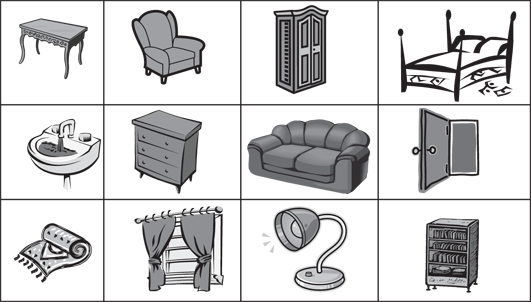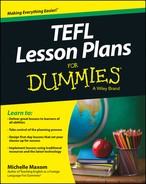Chapter 6
Getting Flash with Flashcards
In This Chapter
![]() Designing a variety of flashcards
Designing a variety of flashcards
![]() Using flashcards in different ways
Using flashcards in different ways
![]() Teaching lower-level students with a flashcards-based lesson
Teaching lower-level students with a flashcards-based lesson
Flashcards are a very traditional teaching resource. Many people envisage a teacher to be a person who sits in front of groups of children showing flashcards for vocabulary and spelling. In reality, flashcards are effective for this purpose, but they’re also ideal for introducing ideas and fixing them in the memories of children and adults alike.
In this chapter, I talk about the advantages of using flashcards in TEFL and the different ways to use them. Then I give you an example of a lesson plan in which you use flashcards as the core resource with elementary-level students.
Using Flashcards as Lesson Context
Flashcards have become a popular resource among educators for many reasons:
- Learning by doing is effective, and flashcards prompt action on the part of the student.
- You can use them in various parts of the lesson to engage students’ minds, introduce key points or to practise language.
- Preparing flashcards is cheap, quick, and easy.
- Flashcards with pictures provide context for vocabulary.
- Students can manipulate the cards (cut them out, turn them over, hold them up), which is interesting and motivating.
- You can easily shuffle and re-order them to provide a greater challenge to the memory.
- You retain the flashcards and can use them to review and repeat language points at regular intervals.
- Students can prepare flashcards themselves and carry them around as learning tools.
- Put the picture on the front and vocabulary on the back.
- Have separate cards for a pair (picture on one, word on the other) to be matched together.
- Put English vocabulary on one side (one for example) and the students’ first languages on the other (, which is one in Korean, for example).
- Put the word in English on one side and its definition in English on the other.
- Put antonyms on either side of the card; for example, hard on one side and soft on the other.
- Get groups of students to prepare cards based on what they’ve learnt that week. Use them to revise at the beginning of the next lesson.
- On one card put many words related to the same topic.
- Put the individual words of a sentence on separate cards for students to put in order.
This lesson is designed to follow other sessions you run about rooms and items in the house. It introduces new vocabulary but draws on previously held knowledge, with speaking as the main skill.
Lesson overview
Doing a warmer activity
![]() 5 minutes
5 minutes
Play a game of ‘I Spy’. Someone says ‘I spy with my little eye, something beginning with … ’ followed by the first letter of something in the room, like ‘b’ for board. The students have to guess what the challenger is thinking of, and the winner then starts a new round. This activity helps students practise the names of items in the room in addition to the alphabet. You should begin the game as the challenger but once the students have correctly guessed the first word, they can play it without you as a whole class.
Introducing the topic
![]() 10 minutes
10 minutes
Students have already learnt words for basic furniture items such as table and chair. Now cut pictures out of a magazine and stick them to cards to show these nouns:
wardrobe chest of drawers rug curtains duvet bed pillow
Draw the basic outline of a bedroom on the board but omit the items that comprise the target vocabulary on the flashcards. As you gradually teach the vocabulary, show each flashcard, drill the word and stick the card to the board. So step by step, you complete your bedroom picture.
Keep pointing to the flashcards to test that students know the word for each item. When they can remember the vocabulary, write the words on the board below each flashcard.
Playing silent bingo
![]() 10 minutes
10 minutes
Prepare bingo cards for the students, but instead of numbers, show six words for household items on each card, including some bedroom vocabulary. Use all the vocabulary for house and home that your class know. Also prepare flashcards of pictures for all the household items on the cards. These you’ll use instead of the traditional numbers called out in a bingo game. I show examples of some bingo cards and flashcards in Figure 6-2.

Figure 6-2: Some bingo cards and flashcards.
Hand out the bingo cards. No more than two students should have the same card. Then silently hold up a flashcard. The students must recall the word for the picture and cross it off in its written form on their bingo card if it’s there. The winner is the student who’s first to cross out all six words on her card. Play four or five rounds of the game.
Doing a bedroom makeover
![]() 10 minutes
10 minutes
Tell the class you don’t like your bedroom because everything in it is old, and you want the students to help you change your room. Introduce old catalogues or online ones (such as Argos and IKEA websites) to the class. Point to each bedroom flashcard and ask students how much they think the item shown costs.
Next, prompt a student to look up a price and help her to do so. For example:
- Teacher: How much is a nice, new wardrobe, Miyuki? Find the wardrobes in this book.
- Student: A nice, new wardrobe costs £300.
Divide the students into small groups and allocate each one a catalogue or website to check. Give each group a few flashcards for bedroom furniture and set the task of checking the price of an item like the one shown on the card. They must write the price on the back of the flashcard.
![]() 5-10 minutes
5-10 minutes
The groups quiz each other by holding up their flashcard and saying, ‘How much is this? What do you think?’ (You may need to review these questions first.) The other groups then guess. Finally, the group holding the flashcard turns it over to reveal the price. Each group has a turn at quizzing the others.
Discussing design
![]() 3 minutes
3 minutes
Ask students to prepare a drawing of their ideal bedroom in their notebooks. They may also check in the dictionary for particular vocabulary they need to describe their picture which is required in the next exercise.
![]() 8 minutes
8 minutes
Put the students in pairs. They must describe their picture to their partner. Put these conversation questions on the board to help the students fuel their discussions:
- Which colours do you like?
- Do you prefer this item of furniture to be big or small?
- How much does this cost?
- Would you like a TV/fire/desk/big window in your bedroom?
![]() 4 minutes
4 minutes
Get feedback from the students by holding up a flashcard, eliciting the name of the item shown and asking a student whether this item appears in their partner’s ideal room. Elicit sentences about the partners of a few of the students like this:
- Teacher: Is there a rug in Charlotte’s room? Tell me about it.
- Student: Yes, there’s a big white rug near the bed and the fire.
Extension activities
Lay out all the flashcards for things in the house. Put the students in pairs. Take the first pair, and arrange one student standing in front of the flashcards and the other with her back to them. State the name of a room in the house. The student near the flashcards must listen to her partner call out the names of things that may be in that particular room. The other student responds by finding the flashcards to match her partner’s words. When the first pair have had a two-minute turn, start again with another pair and a new room.

 You should use any resource that you take time to prepare to full advantage. Here are some ways to use flashcards well:
You should use any resource that you take time to prepare to full advantage. Here are some ways to use flashcards well: This activity helps students become accustomed to authentic material from the real world outside the classroom, which increases their confidence.
This activity helps students become accustomed to authentic material from the real world outside the classroom, which increases their confidence. Let each group have a turn at guessing the price of an item before the true price is revealed. The holder of the flashcard can gesture to make the guesses higher or lower, and build up some anticipation like the old game show Play Your Cards Right (which is a nice game for students to play along with on YouTube, by the way).
Let each group have a turn at guessing the price of an item before the true price is revealed. The holder of the flashcard can gesture to make the guesses higher or lower, and build up some anticipation like the old game show Play Your Cards Right (which is a nice game for students to play along with on YouTube, by the way).